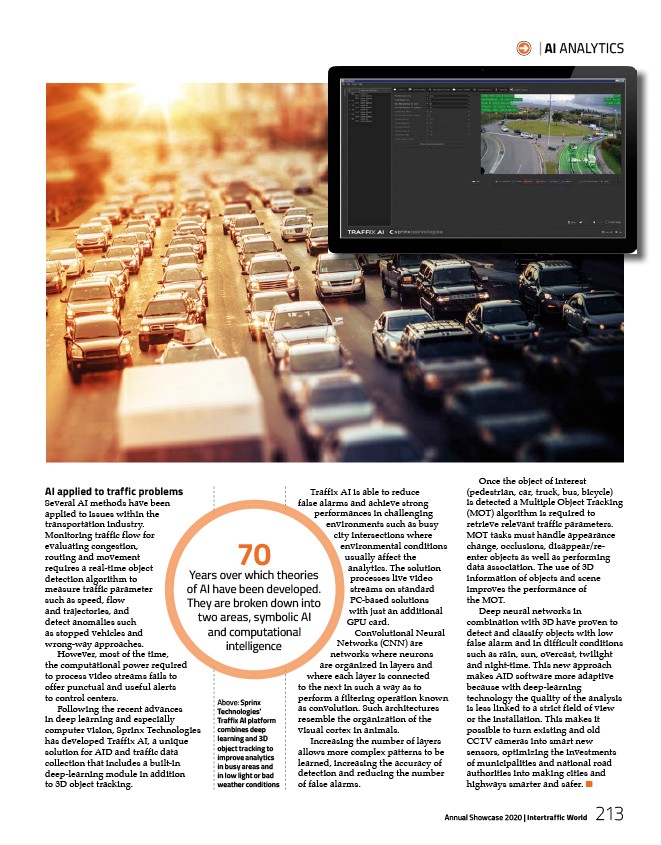
| AI ANALYTICS
Annual Showcase 2020 | Intertraffic World
213
AI applied to traffic problems
Several AI methods have been
applied to issues within the
transportation industry.
Monitoring traffic flow for
evaluating congestion,
routing and movement
requires a real-time object
detection algorithm to
measure traffic parameter
such as speed, flow
and trajectories, and
detect anomalies such
as stopped vehicles and
wrong-way approaches.
However, most of the time,
the computational power required
to process video streams fails to
offer punctual and useful alerts
to control centers.
Following the recent advances
in deep learning and especially
computer vision, Sprinx Technologies
has developed Traffix AI, a unique
solution for AID and traffic data
collection that includes a built-in
deep-learning module in addition
to 3D object tracking.
Traffix AI is able to reduce
false alarms and achieve strong
performances in challenging
environments such as busy
city intersections where
environmental conditions
usually affect the
analytics. The solution
processes live video
streams on standard
PC-based solutions
with just an additional
GPU card.
Convolutional Neural
Networks (CNN) are
networks where neurons
are organized in layers and
where each layer is connected
to the next in such a way as to
perform a filtering operation known
as convolution. Such architectures
resemble the organization of the
visual cortex in animals.
Increasing the number of layers
allows more complex patterns to be
learned, increasing the accuracy of
detection and reducing the number
of false alarms.
Once the object of interest
(pedestrian, car, truck, bus, bicycle)
is detected a Multiple Object Tracking
(MOT) algorithm is required to
retrieve relevant traffic parameters.
MOT tasks must handle appearance
change, occlusions, disappear/reenter
objects as well as performing
data association. The use of 3D
information of objects and scene
improves the performance of
the MOT.
Deep neural networks in
combination with 3D have proven to
detect and classify objects with low
false alarm and in difficult conditions
such as rain, sun, overcast, twilight
and night-time. This new approach
makes AID software more adaptive
because with deep-learning
technology the quality of the analysis
is less linked to a strict field of view
or the installation. This makes it
possible to turn existing and old
CCTV cameras into smart new
sensors, optimizing the investments
of municipalities and national road
authorities into making cities and
highways smarter and safer. ■
70 Years over which theories
of AI have been developed.
They are broken down into
two areas, symbolic AI
and computational
intelligence
Above: Sprinx
Technologies’
Traffix AI platform
combines deep
learning and 3D
object tracking to
improve analytics
in busy areas and
in low light or bad
weather conditions